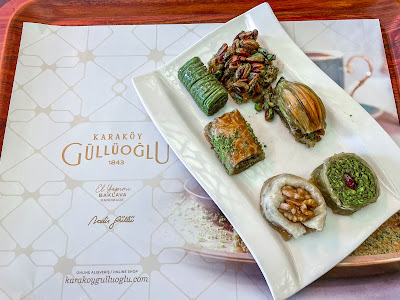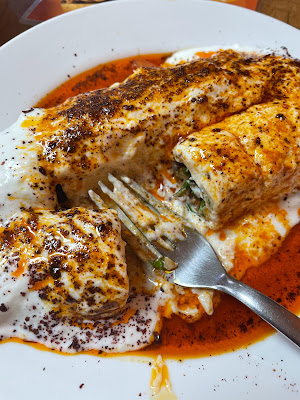A Bite of Istanbul
Istanbul, a city of stark contrast. Modern city on the one hand, cultural sites that are thousands of years old on the other.
Istanbul's history is marked by its transformation from Byzantium to Constantinople and, finally, to the Istanbul we know today, with each era leaving its influence to the modern city’s identity and character.
In this epic journey, we are going to explore some of the cultural sites and modern streets of Istanbul. We will also try some of the local food, interact with the locals, and observe their local norms.
The Cultural Sites
Hagia Sofia
Hagia Sofia has a rich history that spans over 1,500 years. It was originally built as a cathedral by the Roman Emperor Constantine the Great in 537 AD. It underwent a significant transformation in 1453 when the Ottoman Empire, under Sultan Mehmed the Conqueror, conquered Constantinople (now Istanbul). The cathedral was converted into a mosque, and minarets were added to its structure.
 |
| Hagia Sofia |
In 1935, as part of Turkey's secularization efforts. It was converted into a museum for several decades and then in July 2020, Hagia Sophia was reconverted into a mosque by a decree from the Turkish government which decree is still standing until today.
The Hagia Sofia’s architectural splendor and its complex and multifaceted history is truly admirable and something to reflect about.
Blue Mosque
Parallel to the Hagia Sophia is the Blue Mosque. The mosque is renowned for its striking and unique architectural design which is adorned with beautiful Iznik tiles that are primarily in the shades of blue, giving the mosque its popular nickname, the "Blue Mosque."
 |
| One of the Blue Mosque's domes (under rehabilitation) |
The Blue Mosque is an active mosque and one of the most important religious sites in Istanbul. It can accommodate thousands of worshippers and is known for its serene and spiritually significant atmosphere.
Süleymaniye Mosque
The Süleymaniye Mosque was built during the 16th century, between 1550 and 1557, and is one of the masterpieces of Ottoman architecture. It was constructed during the reign of Sultan Süleiman the Magnificent, also known as Süleyman the Lawgiver, and designed by the renowned Ottoman architect Mimar Sinan.
 |
| Süleymaniye Mosque |
 |
| Inner Courtyard of Süleymaniye Mosque |
One of the highlights of visiting the Süleymaniye Mosque is the panoramic view it offers of Istanbul. The mosque is located on one of the city's seven hills, providing stunning vistas of the Golden Horn, the Bosphorus Strait, and the historic district of Sultanahmet.
Ortaköy Mosque
What makes the Ortaköy Mosque especially remarkable is its stunning location along the Bosphorus Strait. It sits right by the waterside on the European side of Istanbul, providing breathtaking views of the Bosphorus Bridge and the Ortaköy Pier.
 |
| Ortaköy Mosque |
Galata bridge
The Galata Bridge has a rich history, and various versions of the bridge have existed in this location for centuries. The current bridge, which is the fifth iteration, was completed in 1994. The first bridge on this site dates back to the Byzantine period.
Along both sides of the upper deck of the bridge, there are numerous restaurants and cafes where you can enjoy traditional Turkish fish sandwiches and other local specialties. It's a great spot to savor fresh seafood while taking in the views of the city.
The Galata Bridge offers fantastic panoramic views of Istanbul, including famous landmarks like the Hagia Sophia, Topkapi Palace, and the Blue Mosque. It's also an excellent spot for watching the bustling boat traffic on the Golden Horn.
Galata tower
One of the primary attractions of the Galata Tower is its stunning 360-degree panoramic view of Istanbul. Visitors can take an elevator or climb the spiral staircase to the observation deck, where they can enjoy breathtaking vistas of the Bosphorus, the Golden Horn, the historic Sultanahmet district, and other landmarks.
 |
Galata Tower |
The Modern Streets
Istiklal
Istiklal Street is a pedestrian-only street, closed to vehicular traffic, which adds to its vibrant and bustling atmosphere. It is lined with shops, cafes, restaurants, art galleries, theaters, and historic buildings.
Istiklal Street is known for its festive atmosphere often decorated with lights that gives a lively ambiance.
Throughout the day and into the evening, you can witness a variety of performances that add to the street's cultural richness and entertainment value.
You'll find solo guitarists, violinists, traditional Turkish instrument players, and even full bands performing a wide range of music styles, from classical to modern pop. These musicians often attract small crowds of passersby who stop to listen and enjoy the music.
Kadikoy
Kadıköy is famous for its bustling street markets and bazaars. The district boasts a wide array of cafes, restaurants, and bars. It's a popular place for locals and tourists alike to enjoy the city's vibrant nightlife. You can find everything from traditional Turkish eateries to international cuisine.
Local Food
Ciya Kebab
Ciya Kebab is associated with the famous Ciya Sofrasi restaurant in Kadikoy, which is renowned for its traditional Turkish and Anatolian cuisine, and kebabs are a prominent part of their menu.
 |
| Ciya kebab and Lenti soup |
Ciya Sofrasi is known for its commitment to preserving and serving authentic Turkish and Anatolian dishes, often made from traditional recipes passed down through generations. The restaurant has gained international recognition for its high-quality, diverse, and flavorful selection of dishes.
If you have the opportunity to visit Istanbul, Ciya Sofrasi is a restaurant well worth trying to get a taste of these delicious kebabs and other Anatolian dishes.
Güllüoğlu Baklava
Baklava is a popular Turkish dessert made from layers of thin pastry dough (phyllo dough) filled with chopped nuts and sweetened with syrup or honey. Güllüoğlu Baklava is celebrated for its mastery in creating a wide variety of baklava with different fillings and flavors. They offer traditional baklava types such as pistachio, walnut, and hazelnut, as well as innovative variations like chocolate baklava and fruit-filled baklava.
.jpg) |
| Karaköy Güllüoğlu |
The Karaköy branch of Güllüoğlu Baklava is a popular destination for locals and tourists who want to experience the rich, sweet, and flaky delights of Turkish baklava. This branch, like others in the Güllüoğlu network, provides a cozy atmosphere and offers visitors the opportunity to enjoy a cup of Turkish tea or coffee alongside their baklava.
 |
| Variety of Baklava |
If you find yourself in Karaköy, Istanbul, and have a sweet tooth, visiting Güllüoğlu Baklava is an excellent way to savor this delicious and iconic Turkish dessert.
Ayran
Ayran is a traditional and popular Turkish beverage that is widely consumed in Turkey and other countries in the Middle East and the Balkans. It is a refreshing and healthy drink made from a simple combination of yogurt, water, and a pinch of salt. It has a tangy and slightly salty taste due to the yogurt and the added salt.
 |
| Ayran |
Lokum
 |
| Lokum served along with Turkish coffee |
Borek
 |
| Börek and çay |
Börek is a pastry dish made from thin layers of dough, often filled with cheese or meat of your choice, and then baked or fried. This is perfect for breakfast.
Yoğurtlu Tavuk
Yoğurtlu Tavuk, which translates to "Chicken with Yogurt" in Turkish is a dish that combines the creamy richness of yogurt with tender pieces of chicken and a variety of spices to create a harmonious and savory flavor.
 |
| Yoğurtlu Tavuk |
Local Norms
Tea, known as "çay" in Turkish, plays a central role in social gatherings, hospitality, and everyday interactions of Turks. Whether you visit someone's home, an office, or a shop, you can expect to be offered a glass of Turkish tea. It is their common way to welcome guests and a gesture of their warmth and friendliness.
 |
| Free çay from a friendly restaurant staff |



Comments
Post a Comment